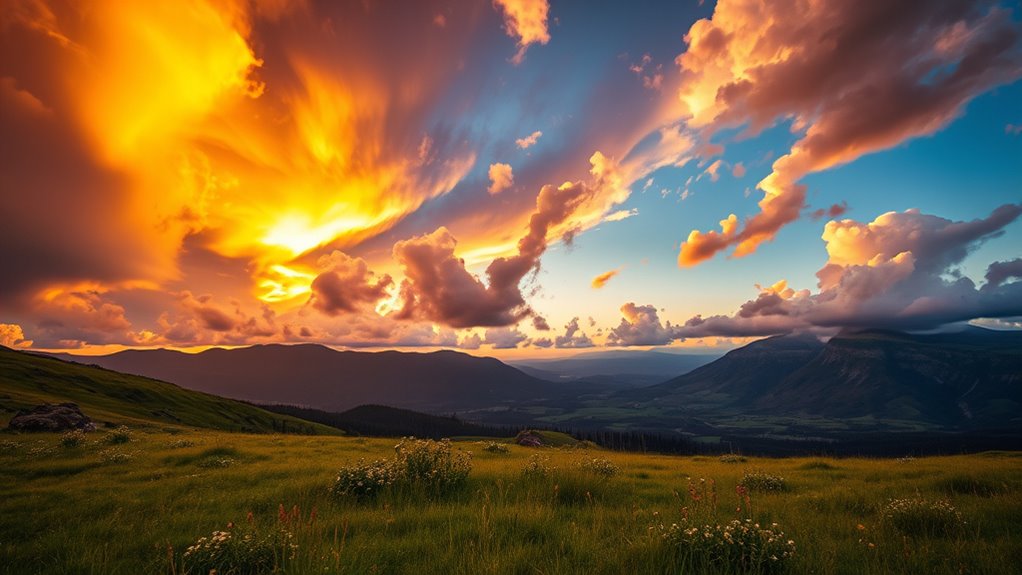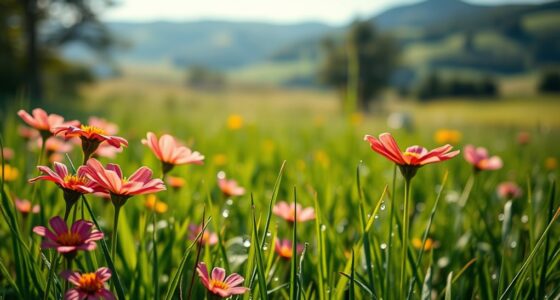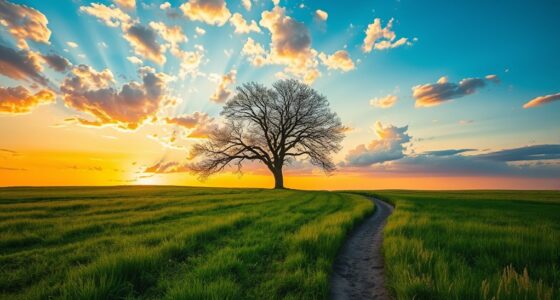Dynamic range in cameras is your ability to capture details in both bright highlights and dark shadows within a single shot. It’s essential for handling high-contrast scenes like sunsets or indoor scenes with windows. A higher dynamic range means more subtle tones and balanced exposure, resulting in more realistic images and videos. Understanding how your camera handles this can help you improve your shots—if you want to know more, keep exploring this essential topic.
Key Takeaways
- Dynamic range measures a camera’s ability to capture details from darkest shadows to brightest highlights.
- Higher dynamic range prevents blown-out highlights and crushed shadows, ensuring more realistic images.
- Sensor size and technology significantly influence a camera’s overall dynamic range performance.
- Proper exposure techniques and HDR merging can optimize dynamic range in challenging lighting conditions.
- Understanding a camera’s dynamic range helps select the right gear for high-contrast scenes and professional quality results.
What Is Dynamic Range and Why Does It Matter?

Have you ever noticed how some photos or videos capture both bright highlights and dark shadows without losing detail? That’s thanks to dynamic range, which defines a camera’s ability to record a wide span of light levels. Sensor technology plays a vital role here, as advanced sensors can detect subtle differences between light and dark areas. Image processing techniques further enhance this by balancing exposure and preserving detail across the entire scene. A camera with a high dynamic range allows you to capture scenes with extreme contrast, making sure neither highlights are blown out nor shadows crushed. Understanding image quality helps you choose the right equipment and settings for stunning results. This capability is essential for producing realistic and visually appealing images and videos, especially in challenging lighting conditions.
How Dynamic Range Affects Your Photos and Videos

Your camera’s dynamic range determines how well it captures details in both shadows and highlights. If the range is limited, you might lose important information in dark or bright areas of your photos and videos. Understanding this helps you create images with balanced exposure and greater visual impact. Additionally, knowing how to optimize your camera settings can help you maximize your camera’s performance potential in capturing a wider dynamic range.
Capturing Detail in Shadows
Capturing detail in shadows is essential for creating balanced and realistic photos and videos, especially when scenes contain a wide range of brightness levels. When your camera has a good dynamic range, you can preserve shadow detail without sacrificing highlights. This allows you to see textures and nuances in darker areas that might otherwise be lost. Contrast enhancement plays a key role here, helping to bring out subtle differences within shadowed regions, making your images appear more natural. If your camera struggles to handle shadows, you’ll notice flat, muddy areas lacking depth. To improve shadow detail, consider using techniques like exposure bracketing or shooting in RAW. These approaches give you more control, ensuring your shadows retain clarity and contribute to an overall well-balanced, compelling shot. Additionally, understanding how dynamic range impacts your camera’s ability to handle bright and dark areas can greatly improve your overall image quality.
Preserving Highlights Effectively
Because highlights are often the brightest parts of an image, managing them effectively is essential for maintaining a natural look. To preserve details, you need to avoid highlight clipping, which causes loss of highlight information and results in blown-out areas. When highlights are clipped, highlight recovery becomes difficult or impossible, so it’s vital to expose properly from the start. Use your camera’s histogram to monitor highlight exposure and adjust settings accordingly. Shooting in RAW format also helps, as it provides more flexibility for highlight recovery during post-processing. If you notice clipped highlights, consider lowering exposure or using graduated filters. By understanding how dynamic range impacts highlights, you can prevent overexposure and retain detail in bright areas, ensuring your photos and videos look balanced and natural. Additionally, mastering the dynamic range of your camera allows you to better capture a wide spectrum of brightness levels, ultimately improving your overall image quality.
The Science Behind Dynamic Range in Cameras

Have you ever wondered what allows a camera to preserve detail in both bright highlights and dark shadows in a single shot? It all comes down to sensor technology and HDR processing. Modern sensors are designed with a wide dynamic range, capturing more tonal information across shadows and highlights. This is achieved through advanced manufacturing techniques that improve pixel sensitivity and reduce noise. Additionally, HDR processing combines multiple exposures to extend the camera’s ability to record detail in extreme lighting conditions. This process intelligently merges images, balancing bright and dark areas without losing detail. The interplay of sensor capabilities and HDR techniques forms the science behind a camera’s dynamic range, enabling you to capture scenes with rich detail from the brightest sky to the darkest shadows. Furthermore, sensor quality plays a crucial role in determining the overall dynamic range a camera can achieve.
Comparing Camera Capabilities: Finding the Right Fit

When choosing a camera, you need to consider sensor size and dynamic range specs to match your shooting needs. Think about practical scenarios like landscapes or portraits to see how each camera performs in real-world conditions. Comparing these capabilities helps you find the right fit for your photography style. Additionally, understanding the color accuracy of a camera can significantly impact your overall image quality and post-processing options.
Sensor Size and Range
Ever wonder how sensor size impacts a camera’s ability to capture a wide dynamic range? It all comes down to the size of the image sensor. Larger sensors typically have more surface area, allowing them to gather more light and detail. This means they can better handle high-contrast scenes, preserving details in shadows and highlights. Smaller sensors, like those in compact cameras or smartphones, often struggle with dynamic range because they can’t collect as much light. When choosing a camera, consider the sensor size because it directly influences your image sensor’s ability to record a broad tonal range. Larger sensors generally deliver superior performance in challenging lighting conditions, giving you more flexibility to capture scenes with high contrast and vibrant detail. Additionally, advanced sensor technology can further enhance the dynamic range, making it easier to capture well-balanced images in complex lighting situations.
Dynamic Range Specifications
Understanding a camera’s dynamic range specifications is essential for choosing the right model for your photography needs. These specs reveal how well your camera captures detail in bright highlights and shadows, directly impacting sensor performance. When comparing models, consider how different cameras handle exposure settings, especially in high-contrast scenes. A higher dynamic range allows more flexibility with exposure, reducing the risk of clipped highlights or lost shadow detail. For instance, selecting a camera with a broader preppy dog names range can significantly improve results in challenging lighting conditions.
Practical Shooting Scenarios
Choosing the right camera depends heavily on how you’ll use it in real-world situations. Different scenarios require cameras that excel in handling exposure adjustments and lighting conditions. To find the best fit, consider these situations:
- Shooting in high-contrast scenes, like sunsets or interiors with windows, where dynamic range is vital.
- Capturing fast-moving subjects outdoors, needing quick exposure adjustments for varying light.
- Photographing low-light environments, where a camera’s ability to manage shadows and highlights makes a difference.
- Video recording in mixed lighting, requiring smooth exposure control for consistent quality.
- Understanding dynamic range capabilities helps you select a camera that can handle diverse lighting conditions without losing detail, making your images look professional and well-balanced.
Tips for Maximizing Dynamic Range in Your Shots

To maximize dynamic range in your shots, start by controlling your exposure carefully. Use exposure bracketing to capture multiple shots at different brightness levels, ensuring you preserve detail in shadows and highlights. This technique is especially useful in high-contrast scenes where a single exposure might lose detail. After shooting, utilize post-processing techniques like HDR merging to combine these images, revealing a wider tonal range. Adjustments in software allow you to balance shadows and highlights more effectively than with a single shot. Consistently practicing exposure bracketing and mastering post-processing will help you maximize your camera’s dynamic range, resulting in more detailed, vibrant photos with rich tonal variations. Sound healing science demonstrates how specific frequencies can influence brainwave patterns, which can be applied to optimize your visual perception and enhance your creative process.
Common Mistakes That Limit Your Dynamic Range

One common mistake that limits your dynamic range is overexposing your shots, which causes highlights to blow out and lose detail. Sensor limitations prevent capturing the full tonal range, especially in high-contrast scenes. Additionally, relying solely on post processing techniques can’t fully recover lost highlight or shadow detail. To avoid these pitfalls:
- Overexposing intentionally to brighten shadows reduces highlight detail.
- Ignoring the camera’s dynamic range capabilities leads to clipped highlights.
- Relying on editing to fix exposure issues instead of proper in-camera adjustments.
- Failing to bracket exposures for HDR merging misses opportunities to maximize detail.
- Not understanding the impact of juice extraction from fruits like oranges can lead to improper exposure settings when shooting in natural light, affecting overall image quality.
Being aware of sensor limitations and adjusting exposure accordingly helps preserve the full tonal spectrum. Proper technique upfront minimizes reliance on post processing to correct exposure mistakes, maintaining image quality.
Frequently Asked Questions
How Does Dynamic Range Influence Post-Processing and Editing Flexibility?
Your dynamic range directly impacts your post-processing and editing flexibility. With a wide dynamic range, you can perform HDR techniques and exposure adjustments without losing details in shadows or highlights. This allows you to recover more information during editing, giving you greater control over the final look. Conversely, a narrow dynamic range limits your options, making it harder to balance highlights and shadows effectively.
Can Smartphone Cameras Effectively Capture High Dynamic Range Scenes?
Smartphone cameras can handle high dynamic range scenes, but they’re like a tightrope walker—balancing between limitations and possibilities. Smartphone limitations mean they might struggle in very bright or dark areas, but using HDR apps boosts their ability to capture more detail across shadows and highlights. You can improve results by manually enabling HDR or using dedicated HDR apps, making your shots more balanced and vibrant even in challenging lighting conditions.
What Are the Best Settings to Optimize Dynamic Range During Shooting?
To optimize dynamic range during shooting, you should use exposure bracketing to capture multiple shots at different exposures, ensuring detail in both shadows and highlights. Enable highlight recovery in your camera settings to preserve bright areas without losing detail. Keep your ISO low for better control, and use a tripod to maintain consistency across brackets. These settings help you achieve balanced images with better highlight and shadow detail.
How Does Sensor Size Impact a Camera’s Dynamic Range Capabilities?
Imagine you’re in a Renaissance painting—big sensors are like grand canvases, offering more room for detail. Larger sensor size greatly boosts your camera performance by capturing a wider dynamic range, helping you keep highlights and shadows intact. Smaller sensors are like tiny sketches—less capable of handling contrast. So, bigger sensors provide better dynamic range, giving you richer images with more detail in challenging lighting conditions.
Are There Specific Lenses That Help Improve Dynamic Range in Photos?
Certain lenses can help improve your photos’ dynamic range, especially those with high-quality lens coatings that reduce flare and ghosting, preserving detail in highlights and shadows. Additionally, lenses with more aperture blades create a more pleasing out-of-focus background, allowing better control over exposure range. Choosing a lens with a wide maximum aperture also lets more light in, helping you capture better detail across bright and dark areas simultaneously.
Conclusion
Now that you understand what dynamic range is and how it impacts your photos and videos, are you ready to push your camera’s limits and capture stunning images? Remember, mastering dynamic range isn’t just about equipment — it’s about technique and awareness. With these tips, you can create more balanced shots that truly stand out. So why settle for less when you can access your camera’s full potential? Start experimenting today!










